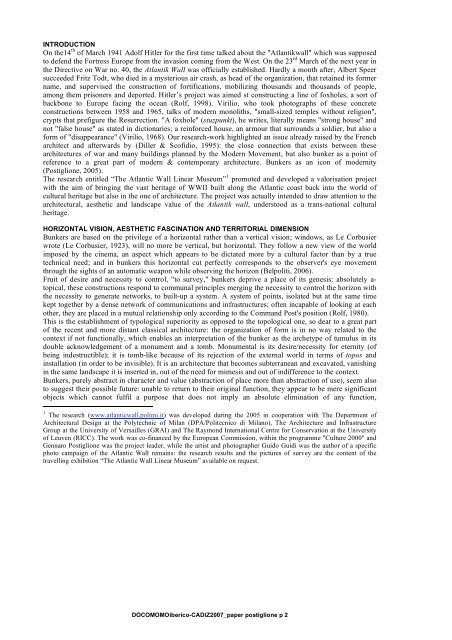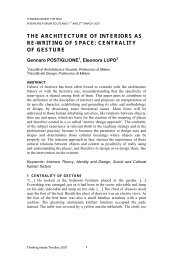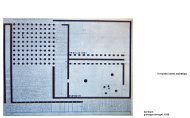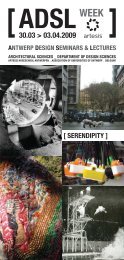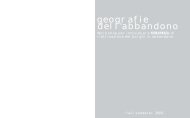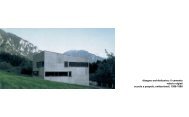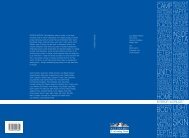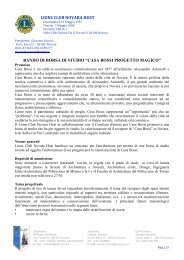the atlantic wall: bunker and/as modern architecture - lablog
the atlantic wall: bunker and/as modern architecture - lablog
the atlantic wall: bunker and/as modern architecture - lablog
You also want an ePaper? Increase the reach of your titles
YUMPU automatically turns print PDFs into web optimized ePapers that Google loves.
INTRODUCTION<br />
On <strong>the</strong>14 th of March 1941 Adolf Hitler for <strong>the</strong> first time talked about <strong>the</strong> "Atlantik<strong>wall</strong>" which w<strong>as</strong> supposed<br />
to defend <strong>the</strong> Fortress Europe from <strong>the</strong> inv<strong>as</strong>ion coming from <strong>the</strong> West. On <strong>the</strong> 23 rd March of <strong>the</strong> next year in<br />
<strong>the</strong> Directive on War no. 40, <strong>the</strong> Atlantik Wall w<strong>as</strong> officially established. Hardly a month after, Albert Speer<br />
succeeded Fritz Todt, who died in a mysterious air cr<strong>as</strong>h, <strong>as</strong> head of <strong>the</strong> organization, that retained its former<br />
name, <strong>and</strong> supervised <strong>the</strong> construction of fortifications, mobilizing thous<strong>and</strong>s <strong>and</strong> thous<strong>and</strong>s of people,<br />
among <strong>the</strong>m prisoners <strong>and</strong> deported. Hitler’s project w<strong>as</strong> aimed st constructing a line of foxholes, a sort of<br />
backbone to Europe facing <strong>the</strong> ocean (Rolf, 1998). Virilio, who took photographs of <strong>the</strong>se concrete<br />
constructions between 1958 <strong>and</strong> 1965, talks of <strong>modern</strong> monoliths, "small-sized temples without religion",<br />
crypts that prefigure <strong>the</strong> Resurrection. "A foxhole" (stuzpunkt), he writes, literally means "strong house" <strong>and</strong><br />
not "false house" <strong>as</strong> stated in dictionaries; a reinforced house, an armour that surrounds a soldier, but also a<br />
form of "disappearance" (Virilio, 1968). Our research-work highlighted an issue already raised by <strong>the</strong> French<br />
architect <strong>and</strong> afterwards by (Diller & Scofidio, 1995): <strong>the</strong> close connection that exists between <strong>the</strong>se<br />
<strong>architecture</strong>s of war <strong>and</strong> many buildings planned by <strong>the</strong> Modern Movement, but also <strong>bunker</strong> <strong>as</strong> a point of<br />
reference to a great part of <strong>modern</strong> & contemporary <strong>architecture</strong>. Bunkers <strong>as</strong> an icon of <strong>modern</strong>ity<br />
(Postiglione, 2005).<br />
The research entitled “The Atlantic Wall Linear Museum” 1 promoted <strong>and</strong> developed a valorisation project<br />
with <strong>the</strong> aim of bringing <strong>the</strong> v<strong>as</strong>t heritage of WWII built along <strong>the</strong> Atlantic co<strong>as</strong>t back into <strong>the</strong> world of<br />
cultural heritage but also in <strong>the</strong> one of <strong>architecture</strong>. The project w<strong>as</strong> actually intended to draw attention to <strong>the</strong><br />
architectural, aes<strong>the</strong>tic <strong>and</strong> l<strong>and</strong>scape value of <strong>the</strong> Atlantik <strong>wall</strong>, understood <strong>as</strong> a trans-national cultural<br />
heritage.<br />
HORIZONTAL VISION, AESTHETIC FASCINATION AND TERRITORIAL DIMENSION<br />
Bunkers are b<strong>as</strong>ed on <strong>the</strong> privilege of a horizontal ra<strong>the</strong>r than a vertical vision; windows, <strong>as</strong> Le Corbusier<br />
wrote (Le Corbusier, 1923), will no more be vertical, but horizontal. They follow a new view of <strong>the</strong> world<br />
imposed by <strong>the</strong> cinema, an <strong>as</strong>pect which appears to be dictated more by a cultural factor than by a true<br />
technical need; <strong>and</strong> in <strong>bunker</strong>s this horizontal cut perfectly corresponds to <strong>the</strong> observer's eye movement<br />
through <strong>the</strong> sights of an automatic weapon while observing <strong>the</strong> horizon (Belpoliti, 2006).<br />
Fruit of desire <strong>and</strong> necessity to control, "to survey," <strong>bunker</strong>s deprive a place of its genesis: absolutely a-<br />
topical, <strong>the</strong>se constructions respond to communal principles merging <strong>the</strong> necessity to control <strong>the</strong> horizon with<br />
<strong>the</strong> necessity to generate networks, to built-up a system. A system of points, isolated but at <strong>the</strong> same time<br />
kept toge<strong>the</strong>r by a dense network of communications <strong>and</strong> infr<strong>as</strong>tructures; often incapable of looking at each<br />
o<strong>the</strong>r, <strong>the</strong>y are placed in a mutual relationship only according to <strong>the</strong> Comm<strong>and</strong> Post's position (Rolf, 1980).<br />
This is <strong>the</strong> establishment of typological superiority <strong>as</strong> opposed to <strong>the</strong> topological one, so dear to a great part<br />
of <strong>the</strong> recent <strong>and</strong> more distant cl<strong>as</strong>sical <strong>architecture</strong>: <strong>the</strong> organization of form is in no way related to <strong>the</strong><br />
context if not functionally, which enables an interpretation of <strong>the</strong> <strong>bunker</strong> <strong>as</strong> <strong>the</strong> archetype of tumulus in its<br />
double acknowledgement of a monument <strong>and</strong> a tomb. Monumental is its desire/necessity for eternity (of<br />
being indestructible); it is tomb-like because of its rejection of <strong>the</strong> external world in terms of topos <strong>and</strong><br />
installation (in order to be invisible). It is an <strong>architecture</strong> that becomes subterranean <strong>and</strong> excavated, vanishing<br />
in <strong>the</strong> same l<strong>and</strong>scape it is inserted in, out of <strong>the</strong> need for mimesis <strong>and</strong> out of indifference to <strong>the</strong> context.<br />
Bunkers, purely abstract in character <strong>and</strong> value (abstraction of place more than abstraction of use), seem also<br />
to suggest <strong>the</strong>ir possible future: unable to return to <strong>the</strong>ir original function, <strong>the</strong>y appear to be mere significant<br />
objects which cannot fulfil a purpose that does not imply an absolute elimination of any function,<br />
1 The research (www.<strong>atlantic</strong><strong>wall</strong>.polimi.it) w<strong>as</strong> developed during <strong>the</strong> 2005 in cooperation with The Department of<br />
Architectural Design at <strong>the</strong> Polytechnic of Milan (DPA/Politecnico di Milano), The Architecture <strong>and</strong> Infr<strong>as</strong>tructure<br />
Group at <strong>the</strong> University of Versailles (GRAI) <strong>and</strong> The Raymond International Centre for Conservation at <strong>the</strong> University<br />
of Leuven (RICC). The work w<strong>as</strong> co-financed by <strong>the</strong> European Commission, within <strong>the</strong> programme "Culture 2000" <strong>and</strong><br />
Gennaro Postiglione w<strong>as</strong> <strong>the</strong> project leader, while <strong>the</strong> artist <strong>and</strong> photographer Guido Guidi w<strong>as</strong> <strong>the</strong> author of a specific<br />
photo campaign of <strong>the</strong> Atlantic Wall remains: <strong>the</strong> research results <strong>and</strong> <strong>the</strong> pictures of survey are <strong>the</strong> content of <strong>the</strong><br />
travelling exhibition “The Atlantic Wall Linear Museum” available on request.<br />
DOCOMOMOiberico-CADIZ2007_paper postiglione p 2


